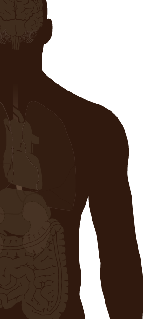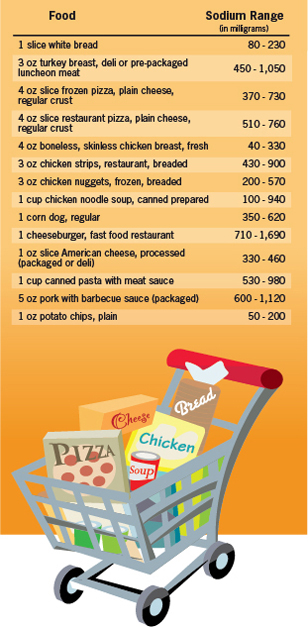Vital Signs: Where’s the sodium?
There's too much in many common foods.
About 90% of Americans eat more sodium than is recommended for a healthy diet. Too much sodium increases a person’s risk for high blood pressure. High blood pressure often leads to heart disease and stroke. More than 800,000 people die each year from heart disease, stroke and other vascular diseases, costing the nation $273 billion health care dollars in 2010. Most of the sodium we eat comes from processed foods and foods prepared in restaurants. Sodium is already part of processed foods and cannot be removed. However, manufacturers and restaurants can produce foods with less sodium. In addition, you can select lower sodium foods when possible and you can cook more foods yourself, to better control how much sodium you eat.
* The words salt and sodium are sometimes used interchangeably because most of the sodium we eat is in the form of salt (sodium chloride). Some salts don’t contain sodium.


9 in 10
About 90% of Americans aged 2 years or older eat too much sodium.*

44%
44% of the sodium we eat comes from 10 types of foods.

$20B
Reducing the sodium Americans eat by 1,200 mg per day on average added up to $20 billion a year in medical costs.
Top Sources of Sodium in the Diet
- Breads and rolls
- Cold cuts and cured meats
- Pizza
- Poultry
- Soups
- Sandwiches
- Cheese
- Pasta dishes
- Meat dishes
- Snacks
Not all foods are created equal
Understanding sodium in foods can be confusing
- Types of foods matter: More than 40% of sodium comes from the following 10 types of foods: Breads and rolls, cold cuts and cured meats such as deli or packaged ham, or turkey, pizza, fresh and processed poultry, soups, sandwiches such as cheeseburgers, cheese, pasta dishes,* meat- mixed dishes such as meat loaf with tomato sauce, and snacks such as chips, pretzels, and popcorn.
- Sources of foods matter: About 65% of sodium eaten comes from food bought at retail stores, so look for lower sodium choices. About 25% comes from restaurants and it can be hard for a person to tell how much sodium is in restaurant foods.
- Brands of foods matter: Different brands of the same foods may have different sodium levels. For example, sodium in chicken noodle soup can vary by as much as 840 milligrams (mg) per serving.
*The pasta dishes category does not include macaroni and cheese. Macaroni and cheese is its own category.
People who should limit their sodium to 1,500 mg a day are:
- People who are 51 years or older
- African American
- People with high blood pressure
- People with diabetes
- People with chronic kidney disease
Eating less sodium is a challenge
- Americans eat on average about 3,300 mg of sodium a day. The U.S. Dietary Guidelines [PDF – 2.89MB] recommend limiting sodium to less than 2,300 mg a day, and about 6 in 10 adults should further limit sodium to 1,500 mg a day.
- Foods that otherwise seem healthy may have high levels of sodium (e.g., cottage cheese and turkey breast luncheon meat).
- Sodium is already part of processed foods and cannot be removed.
- Sodium is included in surprising ways. For example, much of the raw chicken and pork bought from a store has been injected with a sodium solution.
- Too many foods in restaurants are high in sodium.
- Some foods that you eat several times a day, such as bread, add up to a lot of sodium even though each serving is not high in sodium.
Sodium levels of the same food can vary widely, so choose wisely.
This chart shows a range of sodium amounts in different types of food. Serving sizes may vary for some foods, e.g., bread slices which may be lower in sodium because of thinner slices.
Check the Nutrition Facts label which lists sodium content per serving. For help reading labels, visit Sodium Tip Sheet [1.4 MB, 4 pages].

SOURCE: US Department of Agriculture, Agricultural Research Service, National Nutrient Database for Standard Reference, Release 24 and current manufacturer’s data. Note: Values were rounded to the nearest 10 mg.

Sodium adds up quickly in our daily diet
Above is a sample diet of 3 meals and 3 small snacks with a total sodium content of more than 3,200 mg.
SOURCE: US Department of Agriculture, Agricultural Research Service, National Nutrient Database for Standard Reference, Release 24 and current manufacturer’s data.
Note: Values greater than 10 mg of sodium were rounded to the nearest 10 mg.
See the DASH eating plan PDF – 978KB] and other plans at www.choosemyplate.gov.
Places that produce, sell, or serve food can
- Consider joining voluntary initiatives to reduce sodium such as the National Salt Reduction Initiative
- Give choices to consumers to help them reduce sodium in their diet by:
- Stocking lower sodium foods.
- Asking food manufacturers to provide lower sodium foods.
- Make phased reductions in the amount of sodium they add to foods they sell or serve.
- Limit the amount of sodium in food products.
- Provide information about sodium in foods.
Federal government is
- Using the national “Million Hearts™” initiative to prevent a million heart attacks and strokes over the next 5 years. Reducing sodium in the population is a major part of this initiative.
- Encouraging its agencies and departments to adopt the HHS/GSA [1 MB, 20 pages] or similar procurement guidelines that define how much sodium there can be in products that are sold or served in their facilities.
- Improving data collection on sodium, including the amount of sodium people consume, and their knowledge, behaviors and health outcomes.
State and local health departments can
- Develop and implement efforts that:
- Increase public awareness about the amount of sodium added to processed and packaged foods.
- Increase public awareness of the health outcomes of a high-sodium diet.
- Help reduce sodium in people’s diets.
- Encourage reductions in the amount of sodium in foods purchased in cafeterias and vending machines.
Everyone can
- Choose to purchase healthy options and talk with your grocer or favorite restaurant about stocking lower sodium food choices.
- Read the Nutrition Facts label while shopping to find the lowest sodium options of your favorite foods.
- Eat a diet rich in fresh fruits and vegetables and frozen fruits and vegetables without sauce.
- Limit processed foods high in sodium.
- When eating out, request lower sodium options.
- Support initiatives that reduce sodium in foods in cafeterias and vending machines.
- Vital Signs Issue details: Food Categories Contributing the Most to Sodium Consumption — United States, 2007–2008 (MMWR)
- Most Americans Should Consume Less Sodium [10 MB, 144 pages]
- Too Much Sodium [PODCAST – 01:15 minutes]
- Too Much Sodium [PSA – 0:60 seconds]
